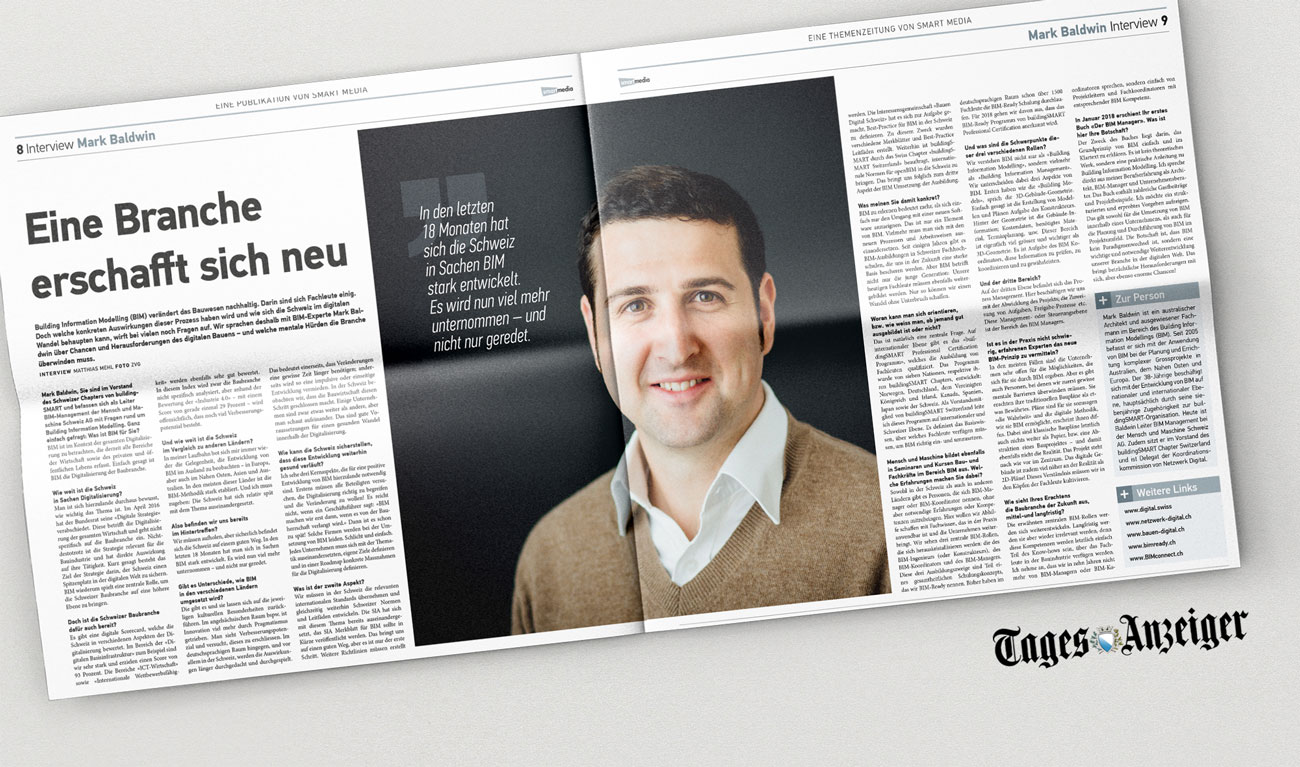
In an interview with Swiss national newspaper, Tagesanzeiger, Mark Baldwin explains how the swiss construction industry is changing.
(Source: Smart Media, Tages Anzeiger, 15th January 2018. Text: Matthias Mehl)
Building Information Modeling (BIM) is sustainably transforming the construction industry. In this, experts agree. But what concrete effects this process will have and how Switzerland can assert itself in the digital revolution raises many questions. That’s why we talked to BIM expert Mark Baldwin about the opportunities and challenges of digital architecture – and what mental hurdles the industry must overcome.
Mark Baldwin, you are on the board of the Swiss Chapter of buildingSMART and, as head of BIM-Management at Man and Machine Switzerland AG, are engaged with the topic of about Building Information Modeling. What is BIM for you?
BIM should be seen in the context of the entire digitalization, which currently covers all areas of the economy as well as private and public life. Simply put, BIM is the digitization of the construction industry.
How far is Switzerland in terms of digitalization?
The importance of this topic is general understood. In April 2016, the Federal Council passed its “Digital Strategy”. This concerns the digitalization of the entire economy and is not specific to the construction industry. Nonetheless, the strategy is relevant to construction and has a direct impact on its activities. In short, the strategy’s goal is to give Switzerland a leading position in the digital world. BIM plays a key role in bringing the Swiss construction industry to a higher level.
But is the Swiss construction industry ready?
There is a digital scorecard that assesses Switzerland in different aspects of digitalization. For example, in the field of “basic digital infrastructure” we are very strong and achieve a score of 93 percent. The sectors “ICT” and “International Competitiveness” are also rated very well. Although the construction industry is not specifically analyzed in this index, the assessment of “Industry 4.0” – with a score of just 29 percent – makes it clear that there is still room for improvement.
And how far is Switzerland compared to other countries?
In my career, I have had the opportunity to observe the development of BIM abroad – in Europe, but also in the Middle East, Asia and Australia. In most of these countries, the BIM methodology is well established. And I have to admit: Switzerland has been a late adopter.
So are we already behind in the process?
We have to catch up, but Switzerland is certainly on the right track. In the last 18 months, BIM has developed strongly. Now much more is being done – and not just talked about.
Are there differences in how BIM is implemented in different countries?
Yes there are; and they can be traced back to the respective cultural-differences. In Anglo-Saxon countries, for example, innovation is more driven by pragmatism. One sees potential for improvement and seeks to realize this. In the German-speaking countries, however, and especially in Switzerland, the approach is rather to analyze, discuss and review. This means, on the one hand, that changes take longer to implement; On the other hand, impulsive or one-sided development is avoided. In Switzerland, we observe that the construction industry is moving more or less as a whole. Some companies are a bit further than others, however, there is a general awareness of where the industry is at. These are good conditions for in the development towards digitalization.
How can Switzerland ensure that this development continues to be healthy?
I see three core aspects that are necessary for a positive development of BIM in this country. First, everyone involved must try to understand digitalization correctly and want change! It is not enough for a manager to say: “We will only do BIM when it is demanded by our clients.” Then it is already too late! Such companies will suffer from the implementation of BIM. Plain and simple. Every company has to deal with the topic individually. They need to define their own goals and set tangible milestones within a company roadmap.
What is the second aspect?
In Switzerland, we must adopt the relevant international standards while at the same time continuing to develop Swiss standards and guidelines. The Swiss Engineers and Architects Association (SIA) is already addressing this issue and the SIA BIM Specification (‘Merkblatt) was published in December 2017. This puts us on the right track, but it’s just the first step. Additional guidelines need to be created. The association “Bauen Digital Schweiz” has set itself the task of defining best practice for BIM in Switzerland. For this purpose, various specifications and best practice guides were created. Furthermore, buildingSMART, through its Swiss Chapter is tasked with bringing international standards for openBIM to Switzerland. This brings us to the third aspect of BIM implementation: education.
What do you mean by that?
Learning BIM means more than just learning how to handle a software. That’s just one element of BIM. One also has to deal with the new processes and ways of working. For some years now, there have been BIM trainings in Swiss universities, which will provide us with a strong base in the future. But BIM does not only affect the young generation: todays industry professionals also need to be educated. Only in this way can create change without disruption.

How do you know if someone is well educated or not?
That is of course a central question. At an international level, there is the buildingSMART Professional Certification Program, which qualifies the training of professionals. The program defines the basic knowledge that professionals must have in order to properly implement and deliver BIM. It has been developed by seven national buildingSMART Chapters: Norway, Germany, the United Kingdom and Ireland, Canada, Spain, Japan and Switzerland. As board member of buildingSMART Switzerland, I lead this program on an international and Swiss level.
Man and Machine also trains industry professionals in the area of BIM. What experiences do you have?
Both in Switzerland and in other countries, there are people who call themselves BIM managers or BIM coordinators who may lack the necessary experience or expertise. Our goals is to help remove this deficit. We seek to deliver knowledge that can be applied in practice and that helps companies to move their business forward. We see three key BIM roles that will emerge: the BIM Engineer (or modeller), the BIM Coordinator and the BIM Manager. These three branches are part of a training concept called BIM-Ready. So far, more than 2,000 experts in the German-speaking world have undergone BIM-Ready training. For 2018, we expect the BIM-Ready program to be recognized by buildingSMART Professional Certification.
And what are the emphases of these three different roles?
We do not see BIM as “building information modeling”, but rather as “building information management”. We distinguish between three aspects of BIM. First, we have the “Building Models”, that is, the 3D building geometry. Simply put, the creation of models and plans is the task of the designer. Behind the geometry is the building information; Cost data, material specification, scheduling, etc. This area is actually much larger and more important than 3D geometry. It is the task of the BIM Coordinator to review, coordinate and validate this information.
And the third area?
On the third level is the process management. Here we deal with the execution of the project; the assignment of tasks, release processes etc. This management or control level is the area of the BIM Manager.
How difficult is it for the more experienced professionals to adopt BIM?
In most cases, companies are very open to the possibilities that BIM offers them. But there are also people who have to first overcome certain mental barriers. They consider their traditional construction plans as something irreplaceable. Plans are for them, so to speak, “the truth” and digital representation appears to them as quite abstract. In the end, 2D plans are nothing more than paper, or an abstraction of a building project – and thus also not the reality. The project stands in center stage. The digital model is actually much closer to reality than 2D plans! We have to cultivate this understanding in the minds of the professionals.
What do you think the construction industry will look like in the medium and long term?
Initially the BIM roles we just discussed will become more established. In the long term, however, they will again become irrelevant! BIM competences will ultimately simply be part of the know-how that construction industry professionals will have. I assume that in ten years’ time, we will no longer talk about BIM managers or BIM coordinators, but simply about project managers and coordinators with the relevant digital competence.
In January 2018 your first book “The BIM Manager” will be published. What is your message here?
The purpose of the book is to explain the basic principle of BIM simply and in plain language. It is not a theoretical work but a practical guide to Building Information Modeling. I speak directly from my professional experience as Architect, BIM Manager and consultant. The book contains numerous guest contributions and project examples. I would like to show a structured and proven approach. This applies both to the implementation of BIM within a company, as well as to the planning and implementation of BIM in the project environment. The message is that BIM is not a paradigm shift, but an important and necessary evolution of our industry in the digital world. This brings with it considerable challenges, but also enormous opportunities!
Mark Baldwin Profile:
Mark Baldwin is an Australian architect and a recognized expert in the field of Building Information Modeling (BIM). Since 2005 he has been involved in the application of BIM in the planning and construction of large scale complex projects in Australia, the Middle East and Europe. The 39-year-old is involved in the development of BIM at national and international level, mainly through his seven-year membership in the buildingSMART organization. Today Baldwin is head of BIM Management at Mensch und Maschine Schweiz AG. In addition, he sits on the board of the buildingSMART Chapter Switzerland and is delegate of the coordination commission of Netzwerk Digital.
Further Resources:
www.digital.swiss
www.netzwerk-digital.ch
www.bauen-digital.ch
www.bimready.ch
www.theBIMmanager.org
